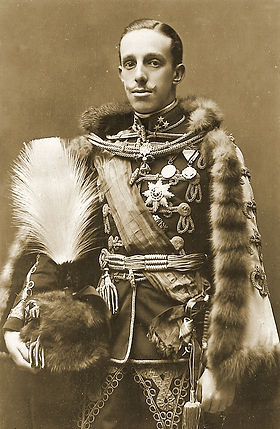

Menu
Potage Crème de perdreaux
Cream of partridge soup
Filets de sole Murat
Timbales of fried sole arranged with diced sautéed artichoke hearts, thin slices of boiled potato and dressed with a lemon butter with parsley
Poulet sauté Demidoff
Stuffed chickens that have first been poached with vegetables in Madeira before being sautéed and served with artichoke hearts topped with fried onion and truffle slices
Baron d’agneau roti, Salade
Baron (two hind legs) of roasted lamb served with salads
Haricots panachés
Mixed beans
Glace Créole
Pineapple ice-cream flavoured with crystallised fruits macerated in rum
Chorizo de Riofrio
Fried slices of the specialty chorizo made in the village of Riofrio, immediately after the Iberian Black pig has been slaughtered at the annual Matanza Festival.

Menu
Soppa de Arroz
Consommé with rice
Filetes de merluza salsa con ostras
Filets of hake dressed with an Oyster sauce
Croquetas de pollo Béchamel
Croquettes of minced chicken blended with Béchamel sauce
Boeuf Mode
Beef that has first been marinated in a mixture of vinegar, onions and spices before being larded and them simmered in a concoction of onions, carrots and turnips; and served with a sauce made from the thickened juices
Patatas
Potatoes
Perdices asadas
Partridges, first marinated in sherry, garlic, sherry vinegar and juniper berries before being barbecued in the traditional asados style over a charcoal pit
Ensalada
Salads
Coliflor salsa holandesa
Cauliflower in Hollandaise sauce
Helado Johannisberg
Red currant sorbet
Pasteleria de hojaldre
Sweet puff-pastries.
The cream of partridge soup and the Poulet sauté Démidoff certainly weren’t Spanish fare, but the fried slices of spicy Chorizo de Riofrio to conclude this 1924 royal dinner, certainly was. This speciality chorizo is made once a year during the traditional slaughter of Iberian black pigs at the Mantanza festival, not far from one of the royal palaces that shares its name with the village, Riofrio.
It seems the menus for King Alfonso XIII of Spain were a regular mishmash of French and Spanish dishes, just as the menus themselves regularly switched from being written in either language, or sometimes both.
The two menus featured here are from the King’s dinner in 1924 and his lunch in 1909. The latter menu also features the tell-tale signs of this cultural confusion with French dishes dressed in Béchamel sauce served alongside Partridges, again, but this time marinated in sherry, sherry vinegar and juniper berries before being barbecued in the traditional Spanish asado style over a charcoal pit.
Perhaps this Franco-Spanish culinary fusion at the royal dining table was caused by a constant stream of head royal chefs gracing the King’s kitchens.
Alfonso XIII had the unique distinction of being born a King and therefore being born with his own royal chef at the waiting. His father, Alfonso XII, had died during his wife’s pregnancy, so when the newborn Alfonso XIII poked his head into the world he was immediately the King of Spain. During his opening hours of life, he perhaps felt like a culinary preparation too, when he was carried naked on a silver tray to be presented to the royal court and Prime Minister as proof of birth and gender.
His mother, Queen Maria Christina, acted as regent until Alfonso XIII turned sixteen.
Up until the King was 8 years-old the head chef was the Spaniard, Loreto Capella Olasagasti, who had commenced his duties in 1883 for the late Alfonso XII. He retired in 1894 and would make a brief return thirteen years later; but not before two French chefs, Eduard Capdeville and Alfonso Berger, and another Spanish chef, José Fermández, had each impressed the royal court with their culinary skills and preparations.
The last chef to Alfonso XIII was again a Frenchman, Gaston Macheral, who oversaw the royal kitchens through to 1931 when the Spanish King and Queen were forced to flee into exile as a republic was proclaimed.
Royal chef, Eduard Capdeville, gave an insight into perhaps why there was a high turnover in royal chefs at the Spanish Court. He once revealed that when he arrived at the palace in 1894, the kitchens were in a poor working state and, in his view, were wanting in hygiene and cleanliness. Of the kitchen staff he complained that their jealousies and rivalries were to such an extent that it compromised the entire service.
Capdeville was also less than subtle about a culture of pilfering revealing that “the best provisions disappeared towards any other place except the royal tables”.
Both these menu-cards are from when Alfonso XIII was married to Queen Victoria Eugenie, the granddaughter of Britain’s Queen Victoria; and carry the couple’s dual monogram of the letter ‘A’ intertwined with the letter ‘V’.

Royal Couple: King Alfonso XIII and Queen Victoria Eugenie in 1930, one year ahead of their exile.

King Alfonso XIII





